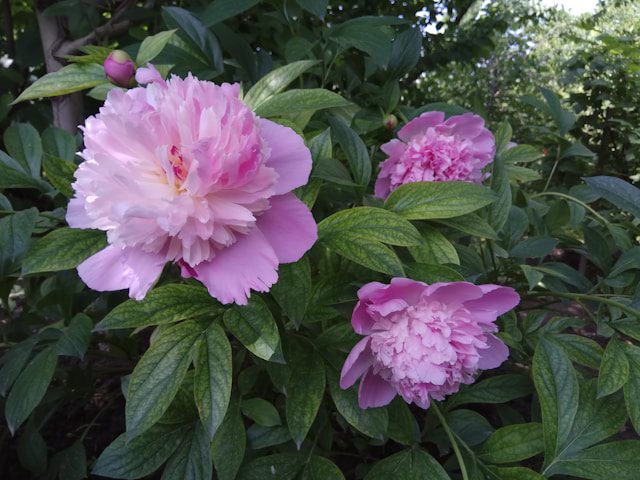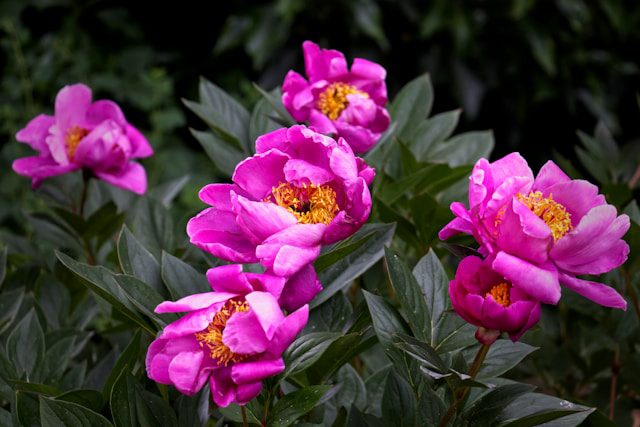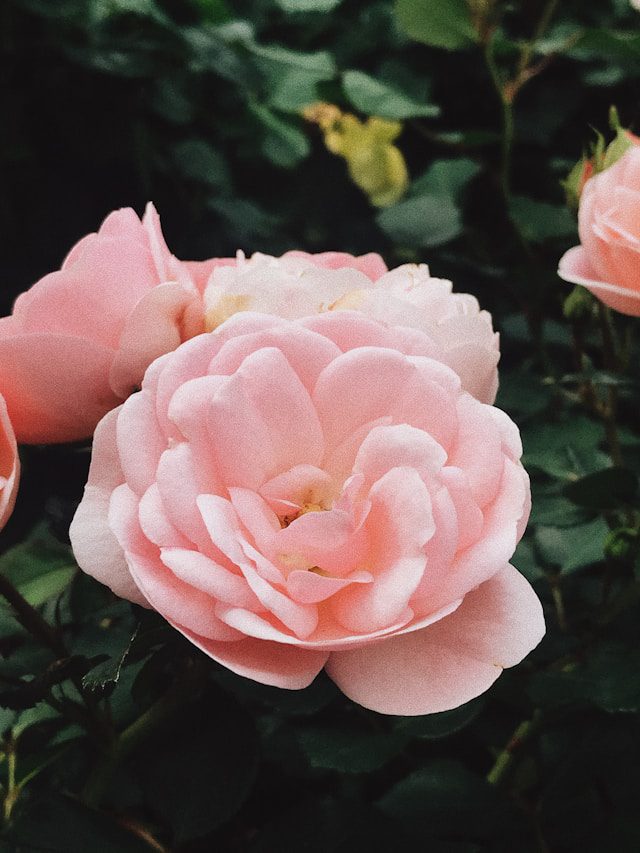Some links on this Website are affiliate links, meaning we may earn a commission if you make a purchase, at no additional cost to you. Please read our full Affiliate Disclosure for more details.
If you’ve ever admired those lush, fragrant blooms in a neighbor’s garden and wondered how to grow peonies yourself, you’re in the right place. Peonies are classic perennials that bring stunning color, texture, and fragrance to any garden.
They’re long-lived, low-maintenance, and a joy to watch as they return stronger every spring.

Why Peonies Are Perfect for Garden Flower Beds
Peonies are one of the most rewarding perennials you can grow. Once established, they require little care and can thrive in the same spot for decades. Their large, showy flowers make them ideal for garden flower beds, borders, or as striking focal points in landscaped areas.
Beyond beauty, peonies are also practical. They attract pollinators like bees, are resistant to most pests, and their cut flowers last long in vases. With the right conditions, your peonies in garden flower beds can become the highlight of your outdoor space for generations.
When to Grow Peonies in the Garden

The success of your peonies largely depends on when you plant them. Timing allows the roots to establish before the next growing season.
- Best Time: The ideal time to plant peonies is in late fall (September to early November). Cooler temperatures help the roots develop without the stress of summer heat.
- Alternative Option: In milder or hot climates, you can plant them in late winter or early spring, just before the new growth begins.
Planting at the right time ensures your peonies settle in well and reward you with healthy growth and abundant blooms the following year.
Choosing Between Bare Root and Potted Peonies
When it comes to planting peonies, you’ll likely find two options at your local nursery: bare root peonies and potted peonies.
Bare Root Peonies:
These are dormant roots typically sold in fall. They may look lifeless, but once planted, they develop strong underground systems and eventually produce large, vibrant flowers. They’re the preferred choice for gardeners who want long-term success.
Potted Peonies:
These are peonies that have already started growing in containers. They’re available in spring and easier for beginners since you can see the developing shoots. You can plant them any time the ground is workable.
If you choose bare roots, make sure the “eyes” (small pink buds) are facing upward when planting. This orientation is essential for proper sprouting.
How Deep to Plant Peony Roots

Planting depth is one of the most common mistakes when growing peonies. If you plant them too deep, they may grow leaves but won’t produce flowers.
- Ideal Depth: Position the root so that the eyes are 1 to 2 inches below the soil surface.
- Spacing: Keep at least 3 to 4 feet between each plant to give them enough room to grow and breathe.
After placing the root horizontally, backfill with loose, well-draining soil and water deeply. Proper planting depth is crucial for healthy blooming year after year.
Why Are Your Calathea Dottie Leaves Turning Yellow?
Best Soil for Growing Peonies in Flower Beds
Peonies thrive best in fertile, well-drained soil that’s rich in organic matter. The soil should be slightly neutral to alkaline (pH 6.5–7.5).
To prepare the perfect peony flower bed, follow these steps:
- Dig a hole about 18 inches wide and deep.
- Mix in compost or well-rotted manure to enrich the soil.
- Avoid heavy clay or compacted soil, as peonies hate sitting in water.
- If your soil tends to hold water, amend it with coarse sand or perlite for better drainage.
Healthy soil gives your peonies the best start and encourages strong root development.
Sunlight and Spacing Requirements

Peonies are sun-lovers, and their flowering potential increases with exposure to light.
- Sunlight: They need at least six hours of direct sunlight daily for optimal growth.
- Spacing: Leave about 3 to 4 feet between plants to ensure good air circulation, which helps prevent fungal problems.
While peonies tolerate partial shade, too much shade will reduce blooming and make the stems weak and floppy.
Peony Care and Maintenance Tips
Taking care of peonies isn’t difficult, but consistent attention helps them stay healthy and vibrant.
1. Watering
Peonies prefer consistent moisture, especially during active growth in spring and early summer. Water deeply once a week, allowing the soil to dry slightly between watering sessions. Avoid overwatering, as soggy conditions lead to root rot.
2. Mulching
Apply a light mulch layer in winter to protect roots from extreme cold. Remove it in spring to prevent moisture accumulation around the crown, which can encourage rot.
3. Fertilizing
Use a balanced fertilizer (10-10-10) in early spring when shoots appear, and again after flowering. Avoid over-fertilizing with nitrogen, as it promotes foliage growth at the expense of blooms.
4. Supporting Peony Stems
Peony blooms are large and heavy, and their stems can easily flop under the weight. To prevent this, use peony rings, cages, or plant supports early in the season so the stems can grow through them naturally.
7 Common Repotting Mistakes You Must Avoid for Healthy Plants
How to Make Peonies Bloom More Flowers

If your peonies are growing but not blooming, don’t worry — it’s usually fixable.
- Ensure Proper Depth: Peonies planted too deep often fail to bloom.
- Give Enough Sun: At least 6 hours of sunlight is essential.
- Feed Wisely: Apply a phosphorus-rich fertilizer to encourage bud formation.
- Deadhead Spent Flowers: Removing faded blooms directs energy toward root and bud development for next year’s flowers.
By addressing these areas, your peonies will reward you with more abundant, colorful blooms every season.
Grow Peonies in Hot Climates
While peonies are typically associated with cooler regions, it’s still possible to grow them successfully in warm areas with the right approach.
- Choose early-blooming varieties like Coral Charm or Festiva Maxima.
- Plant in spots with morning sun and afternoon shade to protect them from scorching heat.
- Apply mulch to help keep the soil cool and retain moisture.
- Water more frequently during dry spells, but ensure proper drainage.
With these adjustments, growing peonies in hot climates becomes entirely manageable.
When to Cut Back Peony Foliage
Cutting back peony foliage is a crucial part of peony care and maintenance. Once the leaves start turning yellow or brown (usually after the first frost) it’s time to prune.
Use clean garden shears to trim all stems down to ground level. Dispose of the old foliage rather than composting it, as it might carry fungal spores that can infect your plants next year. This annual cleanup keeps your peonies healthy and disease-free.
Peony Care Year-Round Checklist
| Season | Tasks |
| Spring | Fertilize with a balanced mix, remove mulch, install plant supports early, and monitor for pests. |
| Summer | Water deeply, deadhead spent blooms, and keep the area weed-free. |
| Fall | Cut back foliage after frost, divide mature plants if necessary, and apply compost to enrich the soil. |
| Winter | In cold regions, add a light mulch layer for protection and remove it in early spring. |
Following this simple seasonal routine ensures your peonies remain strong, healthy, and full of life every year.
Common Peony Problems and Solutions
| Problem | Cause | Solution |
| Peonies not blooming | Planted too deep or too much shade | Replant shallower or move to a sunnier location |
| Stems flopping over | Heavy blooms, lack of support | Use peony rings or cages early in the season |
| Fungal leaf spots | Poor air circulation or overhead watering | Space plants properly and water at the base |
| Ants on buds | Attracted to nectar, harmless to plants | Leave them alone — they help keep pests away |
| Yellowing leaves early | Overwatering or root rot | Improve drainage and reduce watering frequency |
Frequently Asked Questions (FAQ)
1. How deep should I plant peony roots?
Grow peony roots so the buds (eyes) sit 1–2 inches below the soil surface. Planting them deeper can delay or prevent blooming.
2. What is the best fertilizer for peonies in garden flower beds?
Use a balanced fertilizer (10-10-10) or one slightly higher in phosphorus to promote strong roots and larger blooms.
3. When should I cut back peony foliage?
Cut back after the first frost when the leaves start to yellow or die back naturally. This helps prevent disease from spreading.
4. Why are my peonies not blooming?
Peonies might not bloom if they’re planted too deep, get too little sunlight, or are newly transplanted. They can take a year or two to establish.
5. How can I stop peonies from flopping over?
Install peony rings or support cages early in the season before the buds open. This keeps stems upright and prevents damage.
How To Identify Root Rot In Succulents

